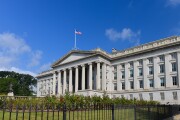The functioning of the U.S. government debt market remains a concern for the Federal Reserve.
In brief remarks delivered at an event hosted by the University of Chicago's Booth School of Business, FedGov. Michelle Bowman said it was important for the central bank to continue working with other regulators to review Treasuries markets to make sure they are appropriately supervised and resilient.
"Doing so can increase the ability of private markets and institutions to function during times of stress and reduce the likelihood of future market interventions by the central bank," she said. "In this regard, it is important for the Federal Reserve to engage along with the other agencies in a thoughtful consideration of possible regulatory adjustments and structural reforms to increase the resiliency of the Treasury markets and reduce the likelihood of future market dysfunction."
Financial regulators in Washington have been studying the impacts of the COVID-19 era actions on Treasury markets. The Interagency Working Group for Treasury Market Surveillance, which consists of the Fed Board of Governors, the Federal Reserve Bank of New York, the Securities and Exchange Commission, the Treasury Department and the Commodity Futures Trading Commission, has issued two reports on the matter during the past two years.
Last fall, SEC Chair Gary Gensler and Treasury Under Secretary for Domestic Finance Nellie Liang called for
During the Friday afternoon event, Bowman moderated a panel discussion on "Design Issues for Central Bank Facilities in the Future." In her opening remarks, she detailed how the Fed's various interventions helped support the U.S. economy in the early stages of the COVID-19 pandemic, including creating lending facilities and buying assets.
The Fed's actions, she said, were integral to preserving the flow of credit in the financial system. But, she noted, some of the various tools the central bank used saw differing levels of use by market participants.
"Significant asset purchases and take-up of the Fed's repo operations were required to restore smooth functioning in Treasury markets because of the liquidity needs of a wide swath of investors," she said. "By comparison, many of the 13(3) lending facilities saw relatively limited take-up, but they helped support market functioning and the supply of credit in the targeted markets by offering a backstop and bolstering investor confidence."
Bowman said the lending programs proved effective because they offered funding at a penalty rate, because it served as a backstop for banks without expanding the Fed's footprint too greatly in any particular market.
Bowman said targeted purchasing was an appropriate response for the Treasuries market, given the severe liquidity shortage in the spring of 2020. But, she said, such programs raise issues that must be addressed by central banks, including how to "clearly distinguish asset purchases from the central bank's monetary policy actions."
Other considerations include how to minimize the Fed's footprint in the market and how to "construct and communicate an exit strategy to reduce the enlarged balance sheet over time."
The Fed stopped purchasing Treasuries and mortgage-backed securities in March 2022 and then began







